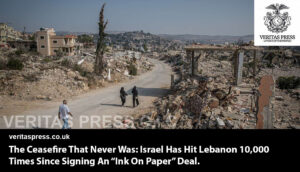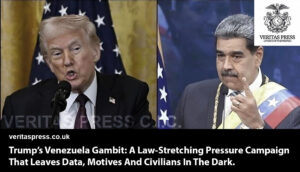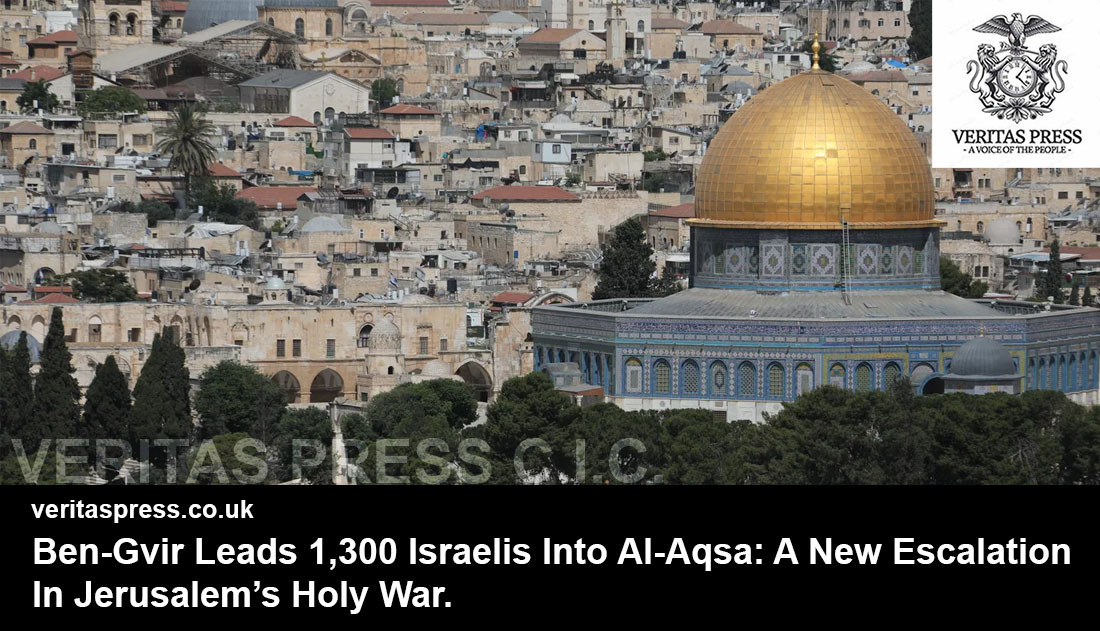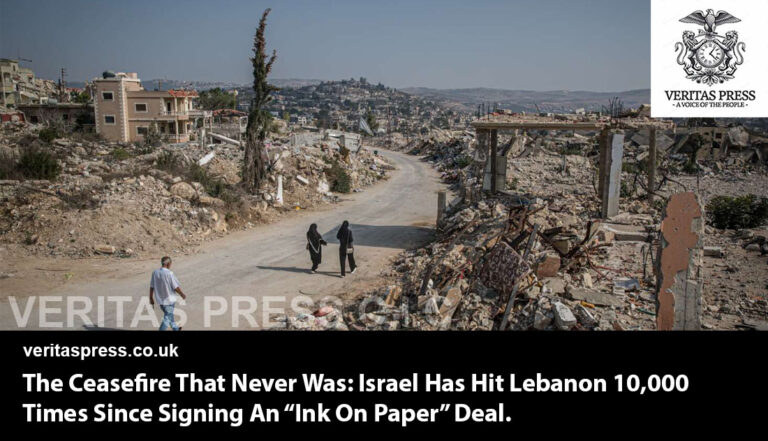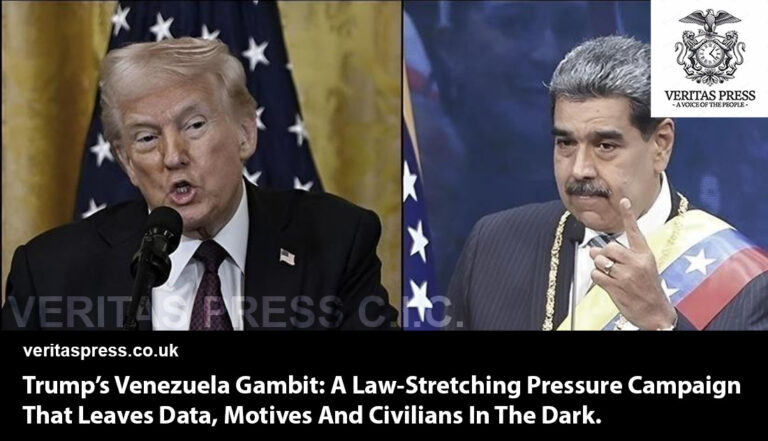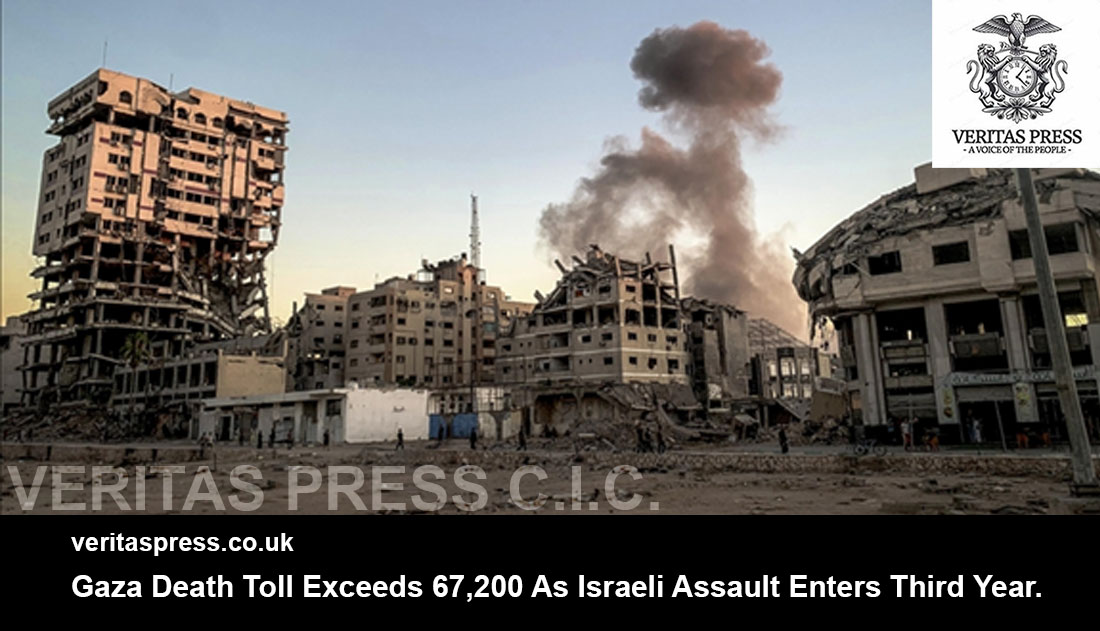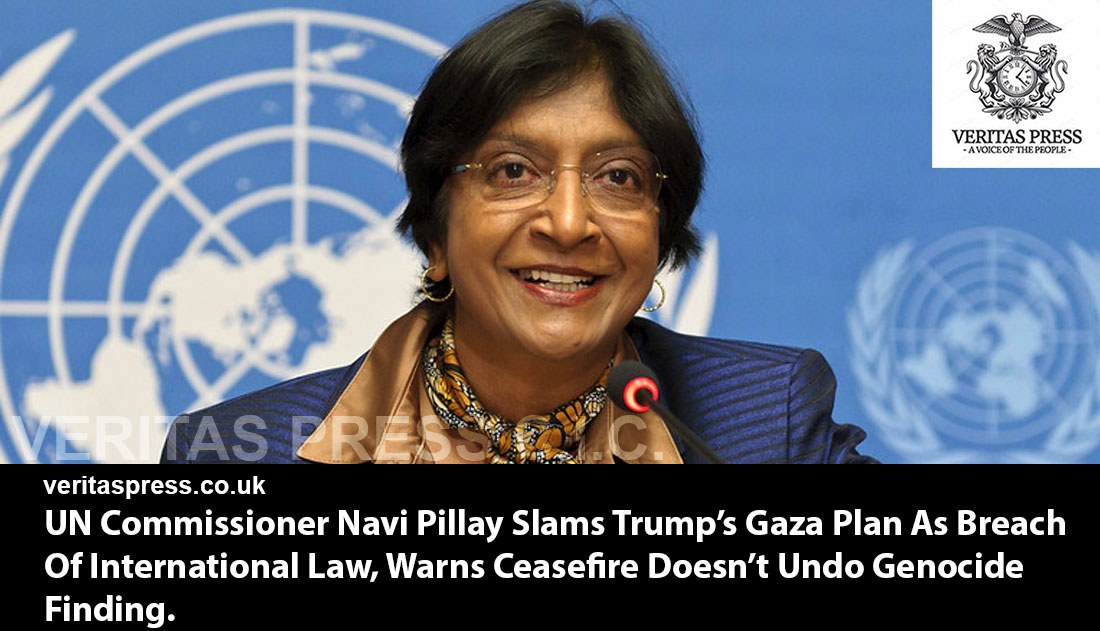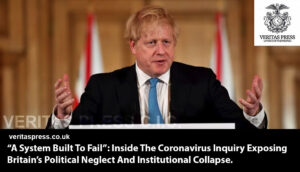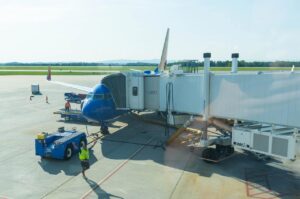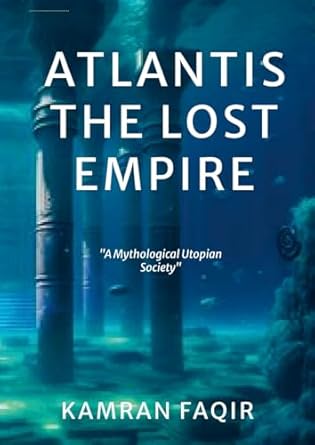Press Release: Veritas Press C.I.C.
Author: Kamran Faqir
Article Date Published: 08 Oct 2025 at 16:53 GMT
Category: Middle East | Palestine-Gaza-West Bank | Ben-Gvir Leads 1,300 Israelis
Source(s): Veritas Press C.I.C. | Multi News Agencies

Business Ads


JERUSALEM / RAMALLAH, 8 October 2025 — On the second day of the Jewish festival of Sukkot, Israeli National Security Minister Itamar Ben-Gvir personally led a group of approximately 1,300 Israeli settlers into the Al-Aqsa / Temple Mount compound in occupied East Jerusalem. Under heavy protection of police and security forces, the minister took part in religious rituals within the courtyards, a move that many see as a deliberate challenge to the longstanding “status quo” governing the site.
The incursion was not only an act of religious symbolism; it came at a critical juncture in indirect ceasefire talks between Israel and Hamas in Egypt. It risked derailing fragile negotiations, inflaming tensions across the Muslim world, and accelerating shifts in control over Jerusalem’s most sensitive space.
This article examines not just what happened, but why it matters: the legal, political and symbolic stakes; the actors involved; and the structural forces pushing Al-Aqsa toward a tipping point.
What Unfolded On 8 October:
The Incursion:
- According to the Islamic Waqf Department in Jerusalem, about 1,300 settlers stormed the compound on Wednesday, following an incursion by about 500 on Tuesday.
- During the entry, Palestinian worshippers were reportedly removed or barred by Israeli police, and strict security measures were imposed around the mosque’s gates and within the Old City precinct.
- Ben-Gvir posted on X (formerly Twitter) that Israelis are “winning on the Temple Mount … We are the owners of the house on the Temple Mount,” and urged Prime Minister Netanyahu to allow a “full victory in Gaza . . . to destroy Hamas.”
- Videos circulating on social media show Ben-Gvir walking across the esplanade, accompanied by religious Jews singing liturgical songs.
- This marks the eleventh visit Ben-Gvir has made to Al-Aqsa in his capacity as national security minister.
Reactions and Condemnations:
- Jordan described the visit as “a flagrant violation” of the status quo and warned of consequences from continued Israeli provocations.
- Saudi Arabia likewise condemned the raid, calling on the international community to hold Israel accountable for violations against Islamic holy sites.
- Hamas, in a statement, labelled the act a “deliberate provocation” and decried the violation of Muslim sanctities worldwide.
- Israeli analysts and NGOs expressed alarm. A recent findings by the Israeli NGO Ir Amim warn that Israel has escalated violations of the status quo and is steadily asserting control over the site.
- In Haaretz, Ben-Gvir’s words drew sharp criticism: “We are the owners of the Temple Mount,” was portrayed not as a symbolic ritual but as a claim of sovereignty over a contested, occupied space.
Beyond The Headlines: Deeper Stakes And Tensions.
1. Erosion of the Status Quo:
The so-called “status quo” refers to a tacit, multilayered understanding, historical, religious, political, and legal, governing who controls and what practices are permitted at the Al-Aqsa / Temple Mount compound. Under that arrangement:
- The Islamic Waqf (under Jordanian custodianship) is nominally tasked with the administration, maintenance, and oversight of religious affairs.
- Non-Muslims may visit the compound (under certain constraints) but are traditionally forbidden to pray there.
- Major structural changes (restorations, excavations, alterations) must not be made unilaterally.
- Enforcement and security are often handled by Israeli authorities, which complicates the enforcement of boundaries and norms.
Over recent years, and particularly since the war in Gaza intensified, critics argue Israel is openly contesting or dismantling parts of this arrangement on the ground.
According to Sheikh Ekrima Sabri, a member of the Jerusalem Waqf Council, Israel “no longer recognises the Hashemite custodianship of Al-Aqsa” in practice. Israeli researchers agree: the police, not the Waqf, now exert direct control in many instances.
The Ir Amim report documents systematic measures: age-based entry bans on Palestinian worshippers, denial of permits, restrictions on Waqf repairs or restorations, arbitrary expulsions, and coordinated incursions timed around Jewish holidays. Aviv Tatarsky, a researcher, warns that Jewish prayer incursions “go hand in hand with the exclusion of Muslims.”
This breach of the status quo is not incremental but seems to be accelerating. The August 2025 incident in which Ben-Gvir led prayers at the Dome of the Rock, historically off-limits to non-Muslims, marked a clear symbolic shift.
2. Political Incentives & Far-Right Strategy:
To understand why Ben-Gvir undertook such a dramatic provocation, one must see the confluence of domestic politics, ideological agendas, and wartime dynamics:
- Personal and party positioning: Ben-Gvir leads Otzma Yehudit (“Jewish Power”), a far-right Kahanist party. His ascendancy has coincided with explicitly messianic rhetoric about reclaiming Jewish sacred spaces.
- Coalitional pressure: As part of Netanyahu’s coalition, Ben-Gvir has threatened to resign unless the government adopts maximalist policies toward Gaza and the Palestinians. His temple-mount actions boost his credibility among hardline voters.
- War and distraction: Israel’s war in Gaza has drawn international attention and condemnation. With focus elsewhere, critics say the government is pushing hard in Jerusalem, anticipating minimal pushback. As Bazbaz (from Waqf) puts it, “The Old City has turned into a ghost town — all attention is on Gaza, while the situation here is forgotten.”
- Incremental takeover logic: Ben-Gvir’s incursions are part of a broader movement known as the “Temple Mount Movement” a messianic ideology that seeks Jewish sovereignty over the compound and eventually reconstruction of an ancient Jewish temple.
- International pushback & sanctions: In June 2025, the U.K., Canada, Australia, New Zealand and Norway imposed sanctions on Ben-Gvir and Finance Minister Bezalel Smotrich, citing incitement to violence. Some European states followed suit. These actions may have hardened Ben-Gvir’s resolve to defy global censure and double down on symbolic gestures.
3. Legal And Normative Dimensions:
From an international law and human rights standpoint, several red flags emerge:
- Occupation and sovereignty: East Jerusalem remains an occupied territory under international law. Israel’s annexation is not recognised by the majority of nations. Any changes to the status of holy sites in occupied territory are governed by the laws of occupation.
- Freedom of worship: The incursion and removal of Muslim worshippers implicate basic rights to religious practice. Enforcing entry restrictions, disproportionately limiting Muslim access during holidays, or expelling custodial Waqf staff raise serious violations.
- Custodianship agreements: Israel’s formal recognition of Jordan’s custodianship of Al-Aqsa (per the 1994 peace treaty) remains a legal reference point. But operationally, Israel seems to treat that recognition as optional.
- Illegality of unilateral alteration: International norms and UNESCO resolutions understand that unilateral alterations of status or access to religious heritage sites in disputed territories are forbidden. The Israeli incursion with prayers, structural interference, or attempted dominance arguably contravenes these norms.
A key question: At what point does repeated, unilateral, provocative entry become de facto transformation of sovereignty, not mere violation, but displacement of the existing regime of religious custodianship?
4. Risk Of Escalation And Wider Repercussions:
- Religious conflagration: The Temple Mount / Al-Aqsa compound is a perennial flashpoint. In 2000, Ariel Sharon’s visit to the site (escorted by heavy security) is widely credited with igniting the Second Intifada.
- Regional backlash: Muslim-majority states may respond diplomatically or militarily. Jordan, as custodian, has limited leverage but symbolic weight. Saudi Arabia’s condemnation signals the risk of wider Arab mobilisation.
- Destabilisation of ceasefire diplomacy: With indirect negotiations between Israel and Hamas underway in Egypt, such provocations could collapse trust or derail frameworks for prisoner exchange or ceasefire.
- Shifting ground realities: If control over access and rituals at Al-Aqsa tilts decisively, the balance in Jerusalem’s Old City could shift irreversibly, granting Israel and ideological settlers operative leverage to reshape sacred space over time.
Critical Gaps, Inconsistencies, And Questions For Investigation:
- What is the precise role of Israeli policing within the compound?
While Israel claims responsibility only for external security, in practice, Israeli forces appear directly to police internal areas of Al-Aqsa during incursions. Where is the line drawn, and who enforces it? Investigative maps or video geolocation could help clarify. - Who decides the timing and approval of ministerial visits?
Were Netanyahu or other security officials aware, complicit, or passive? Was Ben-Gvir acting entirely on his own initiative? The chain of decision-making needs scrutiny. - Why is the Waqf’s authority being undermined, and how systematically?
Reports suggest that Waqf repair work is obstructed, imams are banned, and staff are barred. But documentation is scarce, and many actions occur behind closed gates or under media blackout. How many such violations are recorded, and how are they enforced? - How many Muslim worshippers were denied access, and on what grounds?
The Ir Amim report cites age bans and permit denials. But can names, numbers, and internal criteria be publicly verified? How many permit requests are rejected, and based on what parameters? - What is the capacity of Jordan and international actors to enforce custodianship?
Jordan’s protests are predictable, but do they have real leverage, legal, diplomatic, or even security, to prevent further erosion? Are there treaties or security arrangements that could be invoked? - Are there de facto structural or infrastructural changes underway?
Beyond symbolic incursions, is Israel engaged in construction, changes to pathways, undercutting foundations, or archaeological work to reshape control? Satellite imagery, architectural surveys, or leaked project plans might reveal more. - What is the public perception within Israel’s political, religious, and security establishments?
Do moderate voices within the Israeli military, police, or civil society oppose Ben-Gvir’s tactics? Are there internal memos, dissent, or pushback suppressed from view? - What is the tipping point at which a “status quo violation” becomes an irreversible transformation?
Repeated provocations may reach a threshold where reversal becomes politically or physically infeasible. Identifying that threshold is vital.
Conclusion: A Turning Point In Jerusalem’s Sacred Conflict.
The events of 8 October 2025 are not simply another provocation in the long cycle of tension in Jerusalem. They appear to mark an inflexion point: what once existed as tacit understandings and fragile norms is now being contested in the open. Ben Gvir’s latest incursion into Al-Aqsa Mosque is not an isolated outburst of extremism but part of a deliberate, state-backed project to erase the Islamic identity of Jerusalem and entrench Jewish-Israeli control over its most sacred spaces.
The pattern of violations catalogued by NGOs, journalists, and observers, from repeated settler incursions to police crackdowns on Muslim worshippers, reveals a coherent strategy: to gradually reconfigure control over Al-Aqsa, not through open war, but through relentless, incremental encroachments. These actions transform a living place of worship into a theatre of domination, fragmenting the city’s religious fabric while normalising apartheid under the guise of sovereignty.
The Israeli government’s silence, or tacit endorsement, demonstrates that these are not rogue acts but extensions of official policy. Each raid and restriction serves a larger political design: to erase the Islamic identity, diminish Palestinian, Arab, custodianship, and assert exclusive control over the symbolic heart of the city. The “status quo” long upheld through ambiguity and mutual restraint has now been shattered; what remains is a calculated campaign to redefine Jerusalem’s religious and demographic reality by force of repetition and impunity.
If successful, the consequences will extend far beyond Jerusalem, undermining the integrity of international law, destabilising custodianship agreements, and further entrenching a one-sided system of domination that sustains the Israeli–Palestinian conflict. This situation demands immediate action on three fronts:
- Rigorous independent monitoring — satellite imaging, geolocation data, and civil society documentation must track every alteration to access, infrastructure, and control.
- International diplomatic enforcement — custodianship and protection mechanisms must be actively upheld, not passively ignored.
- Transparency and accountability — governments claiming moral or legal custodianship must act, not merely issue statements.
Ben Gvir’s provocations are more than symbolic; they serve as both tactic and test, gauging how far Israel can go in dismantling the city’s Islamic and Palestinian heritage without consequence. The decades-old equilibrium that once preserved even a semblance of coexistence has collapsed. The question now is not whether the “status quo” is under threat, but whether it is already irreversibly broken, and what that rupture means for the future of Jerusalem itself.


